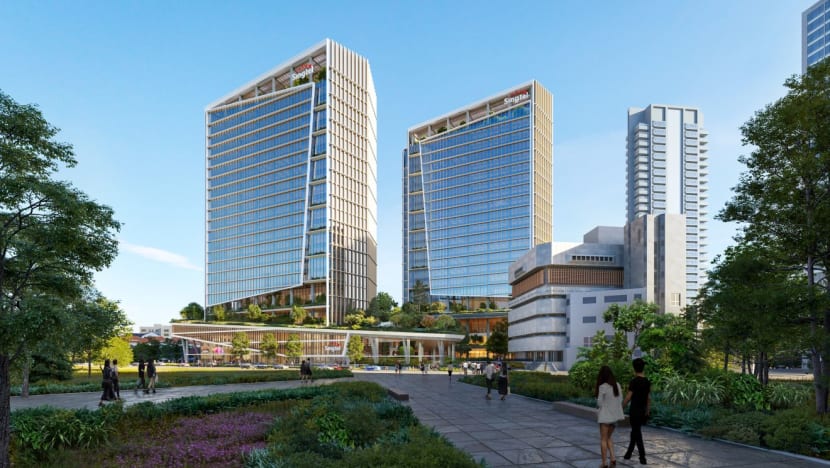Lendlease charts a clear path through the complexity of decarbonisation
By taking steps to measure, reduce and report its Scope 3 emissions, the real estate investor and manager is leading change and amplifying an industry-wide sustainability call to action.

In the redevelopment of Singtel’s Comcentre headquarters, Lendlease and Singtel are collaborating with supply chain partners to integrate low-carbon concrete and steel. Artist's impressions, infographic and photo: Lendlease

This audio is generated by an AI tool.
Decarbonising the built environment, which accounts for 42 per cent of global carbon dioxide emissions yearly, is like training for a major sporting event – a journey that demands clear goals, unwavering determination and significant time investment.
However, unlike a race where one team or individual takes home the gold, the path to decarbonisation requires collective effort to achieve the shared reward of a more sustainable planet. No one wins unless everyone works together, noted Mr Sam Okeby, managing director, Development Asia, Lendlease.
Unfortunately, global investment in decarbonising the built industry still falls short of the net-zero targets set for 2030 and 2050, according to the latest Global Status Report for Buildings and Construction.
“Increasing the pace and scale of decarbonisation is key to achieving the Paris Agreement’s goal of limiting global warming to 1.5 degrees Celsius,” said Mr Okeby. He added that Lendlease, an Australian-headquartered international real estate investor and manager, is focused on reducing emissions across three sources: Direct emissions from owned or controlled sources (Scope 1), indirect emissions from purchased electricity (Scope 2) and indirect emissions spanning its value chain (Scope 3).

DOUBLING DOWN ON SCOPE 3 EMISSIONS
Lendlease embeds sustainability solutions throughout its development and investment activities to create long-term value for investors and tenants. As part of this commitment, the organisation is pursuing ambitious carbon targets validated by the Science Based Target initiative as being aligned with a 1.5 degrees Celsius trajectory.
The company aims to achieve net zero for Scope 1 and 2 emissions by 2025 and absolute zero across Scope 1, 2 and 3 emissions by 2040, within Lendlease’s defined boundaries and without the use of offsets. To reach the 2040 target, Lendlease is setting new standards that prioritise reducing Scope 3 emissions in its carbon strategy.
Ms Cate Harris, group head of Sustainability at Lendlease, and a 2024 Eco-Business Sustainability A-List leader, highlighted that every organisation’s Scope 3 emissions are essentially the Scope 1 or 2 emissions of their suppliers or partners.
In the built environment, Scope 3 emissions encompass those generated upstream – such as the production and transportation of building materials – as well as downstream emissions like the energy use of building tenants.
The interconnected nature of all three scope types means reducing Scope 3 emissions across the industry is essential for achieving successful decarbonisation throughout the entire value chain. For example, when Lendlease purchases low-carbon steel, it not only lowers its own Scope 3 emissions but also encourages suppliers to adopt low-carbon practices, which can help reduce their Scope 1 or 2 emissions.
Lendlease has also developed its Scope 3 Protocol, which outlines the relevant Greenhouse Gas Protocol emission categories within its value chain, supporting its goal of reaching absolute zero by 2040.
“This protocol allows us to sharpen our decarbonisation efforts by clearly defining how we account for these emissions,” explained Mr Okeby. “It’s also designed to guide and align other stakeholders in real estate investment and development.”
By sharing its Scope 3 Protocol, Lendlease reinforces its dedication to transparency and open sourcing. This approach extends to other initiatives, including its Mission Zero Roadmaps and research on electric concrete pumping and the electrification of construction equipment.
Additionally, as a founding member of ResponsibleSteel and SteelZero, Lendlease promotes sustainable steel usage. It also champions the shift to fully electric buildings as a founding supporter of the Global Cooksafe Coalition.
Said Mr Okeby: “We believe an industry-wide focus on Scope 3 emissions will encourage stronger cooperation across the value chain, send a powerful market signal to support investment in harder-to-abate sectors and initiate the next crucial phase in decarbonising the entire building system.”
COLLABORATING WITH LIKE-MINDED PARTNERS
The Scope 3 Protocol reveals that the majority of Lendlease’s Scope 3 emissions come from the materials it purchases, such as steel, cement, glass and aluminium.
Recognising that early intervention is crucial for effective decarbonisation, Lendlease works with suppliers to source low-carbon materials and implement circular practices, including reusing existing structures.
In line with its Mission Zero goals, Lendlease is also forming partnerships with suppliers that share its commitment. One notable collaboration with Permasteelisa, a global leader in designing and installing architectural facades, on the One Sydney Harbour project in Australia has resulted in an estimated 34 per cent reduction in embodied carbon for the aluminium used in Watermans Residences’ facade and a 5 per cent reduction across the entire project.

In Singapore, Lendlease harnessed low-carbon concrete solutions for the construction of Paya Lebar Green. The superstructural concrete used is certified with the top four-tick rating by the Singapore Green Building Council, underscoring its position within the low-carbon range of cement blends. Additionally, all superstructure beams and slabs incorporated Pan-United’s CarbonCure concrete. Together, these initiatives led to an approximate 33 per cent reduction in the embodied carbon of the concrete used.
Similarly, in the redevelopment of Singtel’s Comcentre headquarters, Lendlease and Singtel are working closely with supply chain partners to incorporate low-carbon concrete and steel, with a goal of reducing embodied carbon by up to 30 per cent.

In Kuala Lumpur, Malaysia, Lendlease teamed up with a supplier to create a lower-carbon cement mix for use in the slabs, columns and staircases at The Exchange TRX, resulting in an estimated 25 per cent reduction in embodied carbon for the development’s hotel site.
These partnerships and the resulting carbon savings demonstrate the powerful role collaboration plays in reducing Scope 3 emissions, noted Mr Okeby.
“Decarbonisation, particularly reducing Scope 3 emissions, is challenging. But with the right partner, it becomes far less complex. Lendlease strives to be that trusted partner, helping clients achieve their sustainability goals and unlock the value of decarbonisation by leveraging our ambition, proven experience in delivering targets and deep expertise across the property value chain,” he said.
Learn more about how Lendlease is driving decarbonisation across the property value chain.















